Key words
|
| |
| Angiogenic growth factors, Sponge implantation assay, Terminalia bellirica, Therapeutic angiogenesis. |
| |
INTRODUCTION
|
| |
| Neovascularization is the growth of new capillary blood vessels in the body, is an important natural process in the body used for healing and reproduction. The body controls neovascularization by producing a precise balance of growth and inhibitory factors in healthy tissues. When this balance is disturbed, the result is either too much or too little angiogenesis. Abnormal blood vessel growth, either excessive or insufficient, is now recognized as a “common denominator” underlying many deadly and debilitating conditions, including cancer, skin diseases, age-related blindness, diabetic ulcers, cardiovascular disease, stroke, and many others. [1] |
| |
|
Angiogenesis for Cardiovascular Diseases
|
| |
| Angiogenesis represents an excellent therapeutic target for the treatment of cardiovascular diseases. It is a potent physiological process that underlies the natural manner in which our bodies respond to a diminution of blood supply to vital organs, namely the production of new collateral vessels to overcome the ischemic state. A large number of pre-clinical studies have been performed with protein, gene and cell-based therapies in animal models of cardiac ischemia as well as models of periphery artery diseases. Administration of a particular growth factor (Table.1) to stimulate angiogenesis in the affected tissues (or) organ, the protein therapy with single protein agent was not a viable option to treat ischemic cardiovascular diseases. [2] Therapeutic angiogenesis is the method of stimulation of angiogenesis where it is required but lacking. This technique is used to replenish the blood supply to chronic wounds to speed healing and it prevents unnecessary amputations. New research suggests this approach can be also used to save limbs afflicted with poor circulation and even oxygen starved hearts. [3] Therapeutic angiogenesis may even help to regenerate damaged (or) lost tissues in ways that were previous considered impossible such as with nerves and brain tissues. The modern clinical application of the principle of angiogenesis can be divided into two main areas: Anti-angiogenesis therapies which angiogenesis research began with and Pro-angiogenic therapies. [4] Antiangiogenic therapies are being employed to fight cancer and malignancies which require an abundance of oxygen and nutrients to proliferate. Pro-angiogenesis therapy is being explored as option to treat cardiovascular diseases. One of the first applications of pro-angiogenic methods in humans was a German trial using fibroblast growth factor-1 (FGF-1) for the treatment of coronary artery diseases. Clinical research in therapeutic angiogenesis is ongoing for a variety of diseases like coronary artery diseases, peripheral arterial diseases, and wound healing disorders etc. [5] The proangiogenesis therapies can be differentiated into three categories i) Protein therapy ii) Gene therapy iii) Cell based therapy which involved the implantation of specific cell types, other than the above three therapies there is few therapies only used to induce angiogenesis, So this study is aimed to find potent angiogenic compound from herbals side. Terminalia bellirica has deep roots in Indian mythology as in Ayurveda. It is part of a compound rasayana preparation of three myrobalan fruits, known as Triphala (or trifla), which is important in both Indian and Tibetan traditional medicine. The name Vibheekaki indicates that regular use keeps a person healthy and free from diseases, so fresh leafs of the Terminalia Bellirica Roxb, belonging to the family Combretaceae, commonly known as Bellirica Myrobalan [6] is selected to evaluate its angiogenesis activity. |
| |
MATERIALS AND METHODS
|
| |
|
Plant Material
|
| |
| The Fresh leaves of Terminalia Bellirica were collected from wild area near to Mannargudi, Tiruvarur District, Tamil Nadu, India and the same were authenticated by Prof. Dr. G.S.V. Murthy - Botanical Survey of India (BSI), Coimbatore, India and a voucher specimen No: BSI/SRC/5/23/09- 10/Tech-683 is allotted for Terminalia Bellirica Roxb. (Fig.1) and the herbarium were deposited in our University laboratory for further reference. |
| |
|
Preparation of Ethanolic extract
|
| |
| The leaves of Terminalia bellirica were shade dried and made into small pieces. These pieces were again shade dried and pulverized to the course powder and passed through the 40 number sieve. The powdered materials (leaf) were placed in a thimble of the Soxhlet extraction apparatus attached to the mouth of a round bottomed flask containing 70% ethanol as an extractive solvent. Some boiling chips were added into the flask to avoid bumping during heating. The extraction of leaf was completed in 48 hours. The residue (yield: 30% w/w) was subject to Phytochemical screening. [7] |
| |
|
Phytochemical Screening
|
| |
| Phytochemical screening of Ethanolic extract residue of Terminalia bellirica were carried out using conventional protocol [8] for detecting the presence of different phytochemical active constitutes in the plant respectively and the result is shown in (Table.2). |
| |
QUALITATIVE INSTRUMENTAL ANALYSIS
|
| |
|
Ultra violet and visible spectroscopy
|
| |
| The absorption spectra of plant constituents can be measured in very dilute solution against a solvent blank using and automatic recording spectrophotometer. The UV-Visible spectroscopy of plant extract shows the peak at 255 nm which reveals the presence of proteins. |
| |
|
Infrared (IR) Spectroscopy
|
| |
| I.R. spectroscopy is the study the reflected, absorbed or transmitted radiant energy in region of electromagnetic spectrum ranging from wavelength, 0.8 to 500 nm. Frequency expressed in wave numbers is more commonly used measurement. It is usually divided into 3 regions near I.R. (1250 to 400 cm-1), mid I.R. (4000 to 400 cm-1) and far I.R. (400 to 20 cm-1). The powdered ethanolic extract of Terminalia bellirica was mixed with potassium bromide and a thin disc was prepared in anhydrous conditions. That disc was used for the measurement of I.R. spectra against the potassium bromide disc as reference. The IR-spectra of Ethanolic extract of Terminalia bellirica leaf contain main absorption bands belong to the valence vibrations corresponding to OH, C=O, C-O-C groups to aromatic rings vibrations as well shows in (Fig.2). Spectra examination reveals that the valence vibrations appears in the 2916 cm-1S (CH3CH2) band, 2849 cm-1 (C-H), 1713 (C=O) cm-1, 1612 cm-1 (aromatic C=O), 1450 cm-1 (aromatic C=C ring), 758 and 870 cm-1 ( benzene ring) may be due to the presence of Phytosterols. Also, it is found that the plant contains organic compounds like carbohydrates, cardiac glycoside, chlorophyll and lignins. |
| |
|
Animals
|
| |
| Seven-week-old, specific pathogen-free Male Swiss albino mice weighing between (32-34 g) were purchased from Tamil Nadu Veterinary and Animal Sciences University, Chennai. They were housed in poly propylene cages (4 per cage), maintained in standard lab conditions at 25 ± 2°C, 10% humidity under a 12-h light/dark cycle. They were fed with standard pellet diet and autoclaved tap water ad libitum. All procedures were performed with the animals under general anesthesia, that is, after intraperitoneal injection of sodium phenobarbitone (30 mg/kg). This study was approved by the Institutional Animal Ethical Committee (IAEC), Approval No: Pharm /12/2009-2010 and the all the animal experiments were performed according to the strict guidelines prescribed by CPCSEA. |
| |
|
Acute toxicity studies
|
| |
| Acute toxicity study was carried out on plant extract using female and male Swiss albino mice. The mice were fasted overnight and the weight of each mouse was recorded just before use. The extract was subjected for acute toxicity studies by following the OECD (Organization for Economical Co-operation and Development) guidelines No 425. A group of 5 mice was administered the plant extract in graded doses of 0.25 g/kg, 0.5 g/kg, 1.0 g/kg, 1.5 g/kg, and 2.5 g/kg mice. Mice were continuously observed for mortality and behavioral response for 48 hrs. The dose selection was performed by taking 1/10th of the lethal dose (LD5O). |
| |
EVALUATION AND QUANTIFICATION OF ANGIOGENESIS ACTIVITY
|
| |
|
Chick Chorio-Allantoic Membrane (CAM) Assay
|
| |
| The chickchorio-allantoic membrane (CAM) assay for screening the effect of test samples on angiogenesis was performed according to the method given by Ribatti and co-workers (1997). Fertilized white leghorn chicken eggs were collected from a local hatchery at day’0’ and checked for the damage. The eggs were cleaned with 70 % ethanol and incubated under condition of constant humidity at 37°c. On the 3rd day of incubation a small hole was drilled at the narrow end and 2-3 ml of albumin was withdrawn with 18 gauge hypodermic needle. The window was sealed with transparent tape and again incubated. On the 7th day of incubation a small square window was opened in the shell and sterile gel foam (3mm×3mm×1mm) piece was implanted on top of the membrane. The vehicle control group was impregnated with sterile normal saline, standard group was impregnated with 300 μg of Pyruvic acid [9] and the test group was impregnated with 50, 100, 200, 300μg of the Ethanolic extract of Terminalia bellirica leaf. The eggs returned to the incubator and they were incubated undisturbed till day 14. [10, 11] |
| |
|
Microscopic analysis of Angiogenesis Index
|
| |
| After 14th day of incubation the eggs were removed from the incubator and the CAM tissues directly beneath each sponge was resected from control and treated CAM samples. [12, 13] Tissues were placed in 10 % formalin and stained with hematoxylin and eosin and examined under stereomicroscope at ×50 magnification. The number of vessel branch points contained in a squire region equal to the area of each sponge was counted and findings from 8 CAM preparations were analysed for each treatment group. The resulting angiogenesis index is the mean ± SEM of new branch point in each set of samples. |
| |
RESULTS
|
| |
|
Phytochemical screening and qualitative instrumental analysis
|
| |
| The Phytochemical screening of plant extract revealed the presence of proteins, steroids and terpinoids. The UV-Visible spectroscopy of the plant extract gives maximum absorption at 255 nm may be the presence of proteins and IR-spectra of the plant extract revealed the presence of CH3CH2, (CH), C=O, aromatic C=O, aromatic C=C ring, and benzene ring. The presence of these functional groups also may be due to the presence of proteins. |
| |
|
Ethanolic extract of Terminalia bellirica leaf Stimulates Angiogenesis in ova.
|
| |
| Angiogenic activity of Ethanolic extract of Terminalia bellirica leaf by CAM assay was determined, after 14 days of incubation, strongly elicited on angiogenic response, which is visible with the microscope as a spoke-wheel-like pattern of blood vessels. However, around the control gelatin sponge containing vehicle alone, less growth of new blood vessels was observed (Table.3). As shown in (Fig.3.) Application of 300 μg of Ethanolic extract of Terminalia bellirica leaf exhibits 73.33% of positive response. To test whether EETB induces angiogenesis in a dose-dependent manner, CAM assay was performed with various concentrations (50 to 300 μg/egg) of Ethanolic extract of Terminalia bellirica leaf. The effect of EETB on chick embryonic angiogenesis was increased dose dependently. As seen in the (Table.3) the extract of Terminalia bellirica would enhance the angiogenesis in the CAM. The extract at 300 μg would increase the blood vessel branch formation. The extract promotes new vessel branching formation in a CAM. Angiogenesis effects of Terminalia bellirica extract on the chick CAM. Angiogenesis was induced by gelatin sponge in the absence (Fig.3.), presence of Pyruvic acid 300 μg (Fig.4.) and presence of Terminalia bellirica leaf extract (50 to 300 μg) placed on the CAM surface (Fig.5 to 8.) of a 14- day-old chick embryo (H & E). |
| |
|
Statistical analysis
|
| |
| Statistical comparisons between control and treated groups were carried out using one-way analysis of variances (ANOVA) and differences between groups assessed using Dunnet’s t test. All statistical analysis can be done by using Graph Pad Prism 5 software. |
| |
DISCUSSION
|
| |
| Therapeutic angiogenesis is the method of stimulation of angiogenesis where it is required but lacking. This technique is used to replenish the blood supply to chronic wounds to speed healing and it prevents unnecessary amputations. New research suggests this approach can be also used to save limbs afflicted with poor circulation and even oxygen starved hearts. Therapeutic angiogenesis may even help to regenerate damaged (or) lost tissues in ways that were previous considered impossible such as with nerves and brain tissues. Developing novel angiogenic agents that have a well-developing mechanism of action is most important in angiogenesis field. Three types of therapies were developed up to now those were protein therapy, gene transfer technology and stem cell transplantation which were most costly and have side effects. In this direction the plants are being actively explored as a source of new molecules that can induces angiogenesis. Independent of this effect, in the present study, it is clearly elucidated that angiogenic activity of Ethanolic extract of Terminalia bellirica leaf by performing in-ova angiogenesis assays. It was observed that EETB significantly promotes the development of capillary networks in CAM and these newly synthesized vessels participated actively in the circulating of blood cells in-ova (Fig.8). Taken together, the observations in the present study suggest that Ethanolic extract of Terminalia bellirica leaf exhibits strong angiogenic actions and also may have the potential to be a useful activator of the large number of serious diseases characterized by deregulated angiogenesis. |
| |
CONCLUSION
|
| |
| The preliminary phytochemical screening of the EETB has showed the presence of proteins, sugars, phytosterols, Terpinoids and tannins. The acute toxicity study was carried out at dose level of 2000 mg / kg body weight orally in mice was considered to be safe for pharmacological treatment. The results of this study support the development and use of Terminalia bellirica as a well-tolerated, safe and less cost angiogenic agent with potential angiogenic therapy. The angiogenesis index in the chick CAM was increased in the dose dependent manner. Thus from the microscopic analysis it was observed that Terminalia bellirica is a promising angiogenic agent and this angiogenic activity triggered may be due to the presence of proteins in the plant extract. Further study is required to define more precisely the molecular mechanisms by which Ethanolic extract of Terminalia bellirica leaf modulates endothelial cell function and gene expression as well as the pathological relevance of these findings. |
| |
ACKNOWLEDGEMENT
|
| |
| The authors wish to express their grateful to the Chancellor, PRIST University, Thanjavur and the Chairman K.M. College of Pharmacy, Madurai for providing necessary facilities to carry out this research work. |
| |
Tables at a glance
|
|
|
| |
Figures at a glance
|
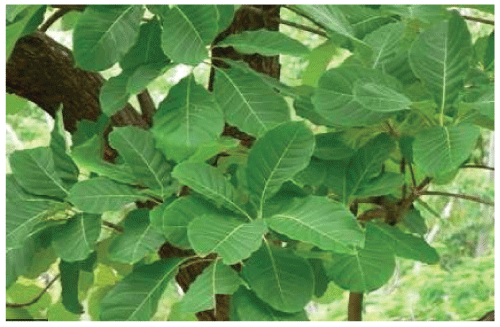 |
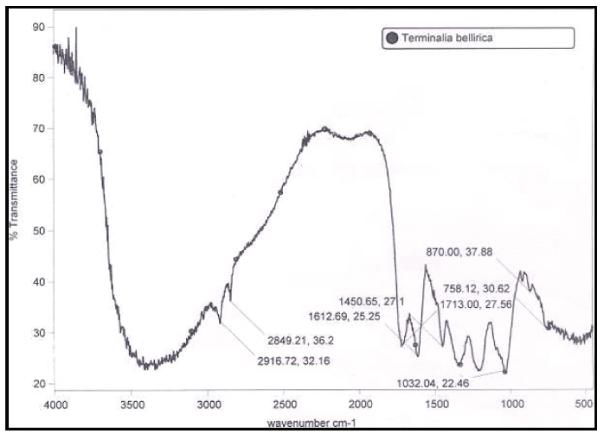 |
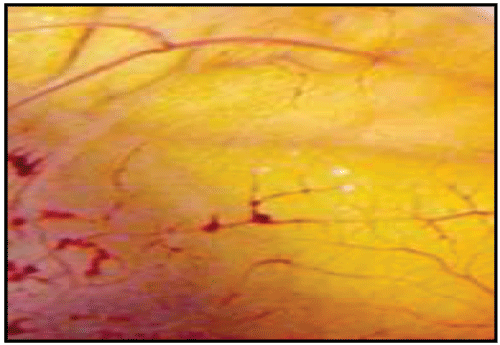 |
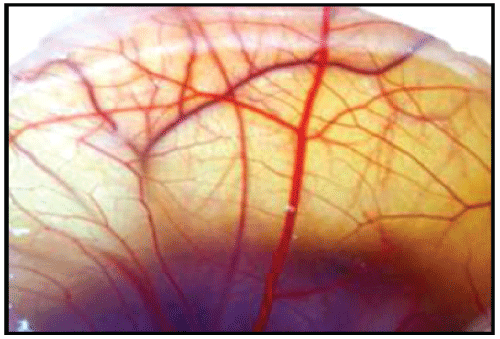 |
| Figure 1 |
Figure 2 |
Figure 3 |
Figure 4 |
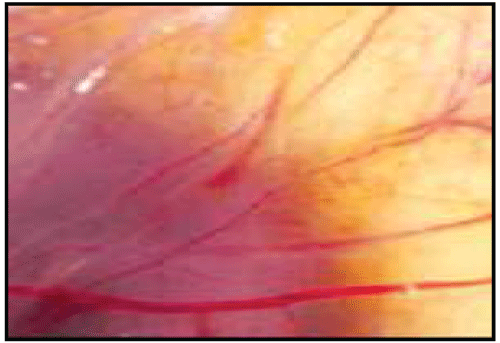 |
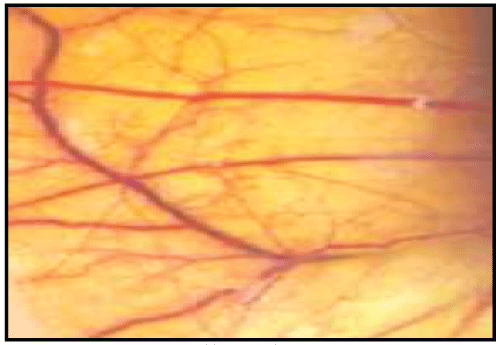 |
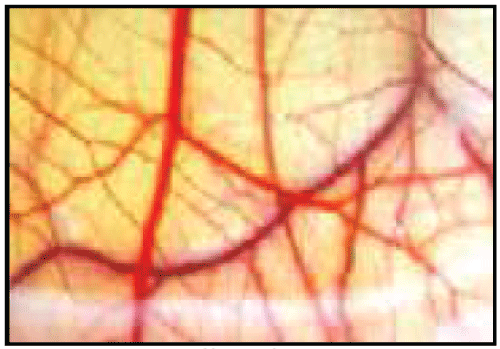 |
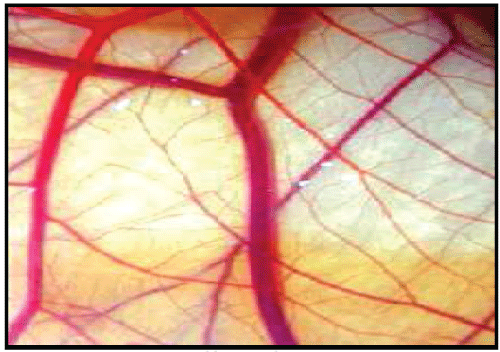 |
| Figure 5 |
Figure 6 |
Figure 7 |
Figure 8 |
|
| |














